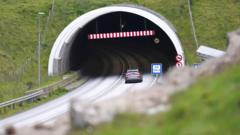In a bid to revolutionize transportation and invigorate economic growth, the Shetland Islands are considering the construction of undersea tunnels, drawing inspiration from the Faroe Islands' noteworthy infrastructure. The archipelago of Shetland is advancing plans to build tunnels connecting its four outlying isles, including the northernmost point of the UK, Unst, moving away from aging ferry systems.
Faroese Prime Minister Aksel Johannesen, speaking from Tórshavn, emphasizes that Shetland could experience similar benefits to those witnessed in his country, where the development of 23 tunnels—four of which are submerged—has bolstered population growth and economic vitality. Initiatives in Shetland are expected to be financed through borrowing, with repayment possibly structured via tolls, setting a precedent for other Scottish islands facing transport challenges.
Critics, however, are frustrated by Scotland's sluggish action regarding similar infrastructure developments. Salmon producer Anne Anderson highlighted this sentiment, noting how a lack of investment is eroding Scotland's market share in global salmon production, while advocating that Scotland learn from the Faroes' proactive approach to tunnel construction.
As one of the world's pioneering nations in tunnel engineering, the Faroe Islands have perfected extensive tunnel networks since the 1960s, drastically improving accessibility and reducing travel time, exemplified by their 7.1-mile undersea tunnel featuring the world's only underwater roundabout—initiatives that support their population of around 54,000 residents.
Echoing this sentiment of ambition, local experts and council officials from Shetland believe that adopting similar tunnel systems could foster community sustainability and economic growth across the islands. The infrastructure would allow residents to thrive in smaller settlements while engaging economically in the larger communities.
Despite the inherent costs of developing tunnels, advocates in Shetland stress the necessity of such infrastructure projects, with Shetland's council already initiating a feasibility study to assess the technical and financial implications of the tunnels. Project proponents like Elizabeth Johnson from Saxavord Spaceport foresee enhanced business opportunities stemming from improved transportation links.
Currently, Shetland's ferry services, which transport about 750,000 passengers a year, are expensive and aging, creating the impetus for a novel transport model focused on undersea tunnels. Recognizing the necessity for sustainable funding mechanisms, council members are amenable to the possibility of tolls—a practice the region's residents seem willing to accept given the existing ferry fares.
While opinions on the implications of tunneling on island life vary, some locals fear that such development could alter the character of their communities. Nevertheless, many acknowledge the critical need for enhanced connectivity due to operational challenges posed by inclement weather affecting ferry services.
With the Shetland Islands poised to transform their transport landscape, advocates argue that the potential benefits of undersea tunnels promise to unlock a host of opportunities, anchoring the region's long-term viability and participation in Scotland's broader economic narrative.




















